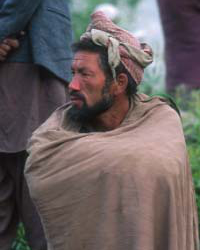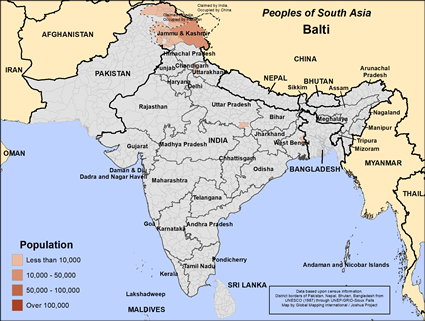Balti in Pakistan

Photo Source:
Dan Bailey
|

Map Source:
People Group data: Omid. Map geography: UNESCO / GMI. Map Design: Joshua Project.
|
| People Name: | Balti |
| Country: | Pakistan |
| 10/40 Window: | Yes |
| Population: | 49,000 |
| World Population: | 102,000 |
| Primary Language: | Balti |
| Primary Religion: | Islam |
| Christian Adherents: | 0.02 % |
| Evangelicals: | 0.02 % |
| Scripture: | Portions |
| Ministry Resources: | No |
| Jesus Film: | Yes |
| Audio Recordings: | Yes |
| People Cluster: | South Asia Tribal - other |
| Affinity Bloc: | South Asian Peoples |
| Progress Level: |
|
Introduction / History
The Burig and the Baltistani Bhotia (or Balti) are two ethnic groups of Tibetan origin that live in the Karakoram Mountains of northern Pakistan. This region is known as Baltistan. These are only two known Tibetan groups that have converted to Islam. This possibly occurred as a result of outside contacts in the form of trade, diplomatic ties, military raids, or migrations of Muslim peoples.
Tibet flourished as an independent kingdom from the seventh century A.D. until the 1700s, when it came under nominal Chinese control. Tibet reasserted its independence in 1911. However, China again invaded in 1950 and fought to gain control of what was considered a strategic border area in Tibet. When Tibet officially became an autonomous region of China in 1965, thousands of Tibetans fled to India, following their religious leader, the Dalai Lama. However, many centuries before that time, the Burig and the Baltistani Bhotia had already been well established in Pakistan. They had their own Balti states, which were gradually absorbed into the British-Indian empire beginning in 1840.
What Are Their Lives Like?
Although the Tibetans in Pakistan have been Muslim for more than 500 years, their Tibetan roots can still be seen in their architecture, clothing, food, folklore, and language. Both the Baltistani Bhotia and the Burig speak archaic Tibetan dialects that resemble seventh century classical Tibetan. These two groups are the most westerly extension of the Tibetan-Burman language family.
Before 1947, trade and travel between the people of the Balti states and their Indian neighbors were constant. However, since the partition of Pakistan and India in 1947, Baltistan (and the Tibetans) have been more isolated. There is very little crime in Baltistan.
The Balti live in the arid Karakoram Mountain region. Their communities are located between the international borders of western China and the northern section of the disputed Kashmir territories of India and Pakistan. The mountains are rugged and harsh, receiving only six inches of rain annually; therefore, the Balti depend heavily on glacial runoff to irrigate their crops. Barley, wheat, and millet are grown where water is sufficient. The hot summer temperatures also allow for a wide variety of fruits to be raised. Apricots are a staple fruit, and the Balti people even eat the pits. Butter tea is a primary staple.
The Balti are not nomadic like the other ethnic groups in the area. Instead, they transfer their livestock from one grazing ground to another with the changing of seasons. During the summer months, they drive the herds to alpine pastures. All households have at least one female zmo, which is a cross between a cow and a yak. Dairy products are made from the milk of these animals.
The old tradition of an artisan class remains among the Balti. This class is made up of craftsmen such as blacksmiths and cabinetmakers. The artisans travel from village to village and are paid for their work with butter and wheat.
Tibetan communities are located in the fertile narrow valleys formed by the tributaries of the Indus River. Their villages consist of tightly clustered stone and mud houses that are connected by narrow passageways. A typical Tibetan house in Pakistan has a basement or lower level, a ground level with several rooms, and a flat roof, which serves as a third level. At night the family's sheep, goats, and yaks are kept in the basement, or balti. This is the term after which the Balti were named. In the summer, the families do much of their work and other activities on the roof.
The Balti in Pakistan wear traditional wool clothing. The men wear white woolen garments, while the women wear black wool. Both men and women wear skull caps decorated with flowers, berries, or leaves.
What Are Their Beliefs?
Centuries ago the Balti were Buddhist. They were converted to Islam from the 14th through the 17th centuries due to efforts led by Sufi missionaries. Today many adhere to Sufi practices, but a small majority are Shia Muslims. A smaller number of them are Sunni Muslims like the Pakistani majority. They have Muslim training schools taught by spiritual guides who have attained a certain degree of spirituality. Their Tibetan Buddhist roots show through when they continue to practice Bon, the Tibetan form of shamanism.
What Are Their Needs?
The Balti people need to know that their true identity can only be found through knowing Jesus Christ.
The disputed Kashmir region forms the southeastern border of Baltistan. Consequently, the whole region has generally been closed to foreign travelers for a number of years, which has prevented missions work among them. This region is always in danger of skirmishes between Pakistan and India.
Prayer Points
Ask God to send medical teams and humanitarian aid workers to minister to the Balti of Pakistan.
Pray for spiritual hunger among the Balti people, and that they will have easy access to gospel materials.
Pray for the physical and spiritual needs to be met by the loving hands of Father God.
Pray for a powerful movement to Christ among the Balti people.